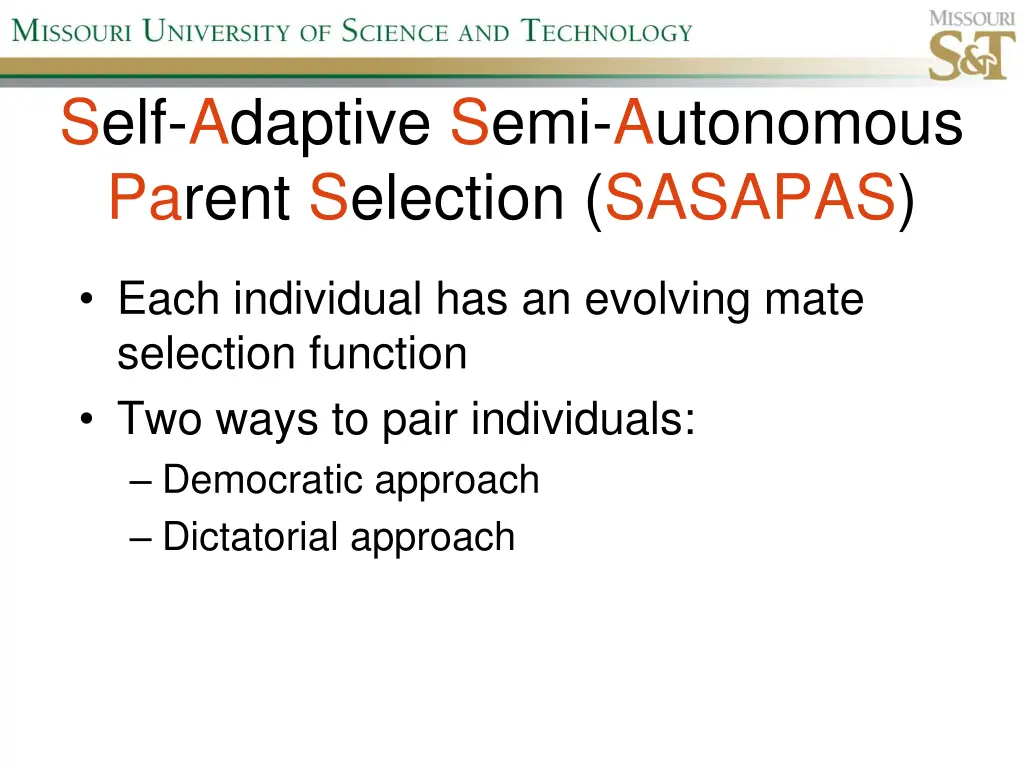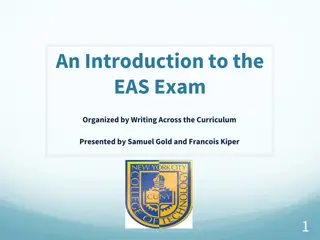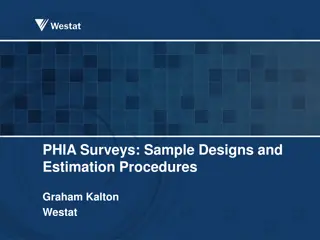
Evolutionary Mate Selection Methods and Function Representation
Explore self-adaptive and semi-autonomous mate selection approaches like SASAPAS and SASADIPS, where individuals evolve mate selection functions. Dive into democratic and dictatorial pairing methods, along with mate selection function representation and evolution. Experiment with deceptive traps and highly evolved mate selection techniques.
Download Presentation

Please find below an Image/Link to download the presentation.
The content on the website is provided AS IS for your information and personal use only. It may not be sold, licensed, or shared on other websites without obtaining consent from the author. If you encounter any issues during the download, it is possible that the publisher has removed the file from their server.
You are allowed to download the files provided on this website for personal or commercial use, subject to the condition that they are used lawfully. All files are the property of their respective owners.
The content on the website is provided AS IS for your information and personal use only. It may not be sold, licensed, or shared on other websites without obtaining consent from the author.
E N D
Presentation Transcript
Self-Adaptive Semi-Autonomous Parent Selection (SASAPAS) Each individual has an evolving mate selection function Two ways to pair individuals: Democratic approach Dictatorial approach
Self-Adaptive Semi-Autonomous Dictatorial Parent Selection (SASADIPS) Each individual has an evolving mate selection function First parent selected in a traditional manner Second parent selected by first parent the dictator using its mate selection function
Mate selection function representation Expression tree as in GP Set of primitives pre-built selection methods
Mate selection function evolution Let F be a fitness function defined on a candidate solution. Let improvement(x) = F(x) max{F(p1),F(p2)} Max fitness plot; slope at generation i is s(gi)
Mate selection function evolution IF improvement(offspring)>s(gi-1) Copy first parent s mate selection function (single parent inheritance) Otherwise Recombine the two parents mate selection functions using standard GP crossover (multi-parent inheritance) Apply a mutation chance to the offspring s mate selection function
Experiments Counting ones 4-bit deceptive trap If 4 ones => fitness = 8 If 3 ones => fitness = 0 If 2ones => fitness = 1 If 1 one => fitness = 2 If 0 ones => fitness = 3 SAT
SASADIPS shortcomings Steep fitness increase in the early generations may lead to premature convergence to suboptimal solutions Good mate selection functions hard to find Provided mate selection primitives may be insufficient to build a good mate selection function New parameters were introduced Only semi-autonomous
Greedy Population Sizing (GPS)
The parameter-less GA Evolve an unbounded number of populations in parallel Smaller populations are given more fitness evaluations Fitness evals |P1| = 2|P0| |Pi+1| = 2|Pi| Terminate smaller pop. whose avg. fitness is exceeded by a larger pop. P0 P1 P2
Greedy Population Sizing F4 Fitness evals F3 F2 Evolve exactly two populations in parallel F1 Equal number of fitness evals. per population P0 P1 P2 P4 P3 P5
GPS-EA vs. parameter-less GA Parameter-less GA 2N 2F1 + 2F2+ + 2Fk + 3N 2F4 GPS-EA F1 + F2+ + Fk + 2N N N N F4 2F3 F3 2F2 N F4 F2 2F1 F1 F3 F2 F1
GPS-EA vs. the parameter-less GA, OPS-EA and TGA Deceptive Problem 100 % of maximum fitness GPS-EA < parameter-less GA TGA < GPS-EA < OPS-EA 95 90 MBF 85 80 100 100 500 1000 % of maximum fitness best solution found problem size 95 OPS-EA TGA GPS-EA parameter-less GA 90 85 80 100 500 1000 problem size GPS-EA finds overall better solutions than parameter-less GA OPS-EA TGA GPS-EA parameter-less GA
Limiting Cases 80 Avg. Pop. Fitness Favg(Pi+1)<Favg(Pi) No larger populations are created No fitness improvements until termination 60 40 20 0 1 2 3 4 5 6 7 8 9 10 11 Fitness Evals 100 P3 P4 80 % of runs 60 40 20 0 Approx. 30% - limiting cases Large std. dev., but lower MBF Automatic detection of the limiting cases is needed 100 500 1000 problem size limiting cases non-limiting cases
GPS-EA Summary Advantages Automated population size control Finds high quality solutions Problems Limiting cases Restart of evolution each time
Estimated Learning Offspring Optimizing Mate Selection (ELOOMS)
Traditional Mate Selection 5 3 8 2 4 5 2 MATES t tournament selection t is user-specified 5 4 5 8
ELOOMS YES YES MATES YES YES NO NO YES
Mate Acceptance Chance (MAC) d1 d2 d3 dL k How much do I like ? j b1 b2 b3 bL L = ( 1) + (1 ) b (1 ) b d i i i = ( , ) MAC j k 1 i L
Desired Features d1 d2 d3 dL j b1 b2 b3 bL # times past mates bi = 1 was used to produce fit offspring # times past mates bi was used to produce offspring Build a model of desired potential mate Update the model for each encountered mate Similar to Estimation of Distribution Algorithms
ELOOMS vs. TGA Easy Problem L=1000 With Mutation L=500 With Mutation
ELOOMS vs. TGA Deceptive Problem L=100 Without Mutation With Mutation
Why ELOOMS works on Deceptive Problem More likely to preserve optimal structure 1111 0000 will equally like: 1111 1000 1111 1100 1111 1110 But will dislike individuals not of the form: 1111 xxxx
Why ELOOMS does not work as well on Easy Problem High fitness short distance to optimal Mating with high fitness individuals closer to optimal offspring Fitness good measure of good mate ELOOMS approximate measure of good mate
ELOOMS computational overhead L solution length population size T avg # mates evaluated per individual Update stage: 6L additions Mate selection stage: 2L*T* additions
ELOOMS Summary Advantages Autonomous mate pairing Improved performance (some cases) Natural termination condition Disadvantages Relies on competition selection pressure Computational overhead can be significant
Expiration of population Pi If Favg(Pi+1) < Favg(Pi) Limiting cases possible If no mate pairs in Pi (ELOOMS) Detection of the limiting cases 100 80 Avg. Pop. Fitness 80 60 % of runs 60 40 40 20 20 0 0 1 2 3 4 5 6 7 8 9 10 11 100 500 1000 problem size Fitness Evals P3 P4 limiting cases non-limiting cases
Comparing the Algorithms Deceptive Problem L=100 Without Mutation With Mutation
GPS-EA + ELOOMS vs. parameter-less GA and TGA Deceptive Problem L=100 Without Mutation With Mutation
GPS-EA + ELOOMS vs. parameter-less GA and TGA Easy Problem Without Mutation With Mutation L=500
GPS-EA + ELOOMS Summary Advantages No population size tuning No parent selection pressure tuning No limiting cases Superior performance on deceptive problem Disadvantages Reduced performance on easy problem Relies on competition selection pressure






















